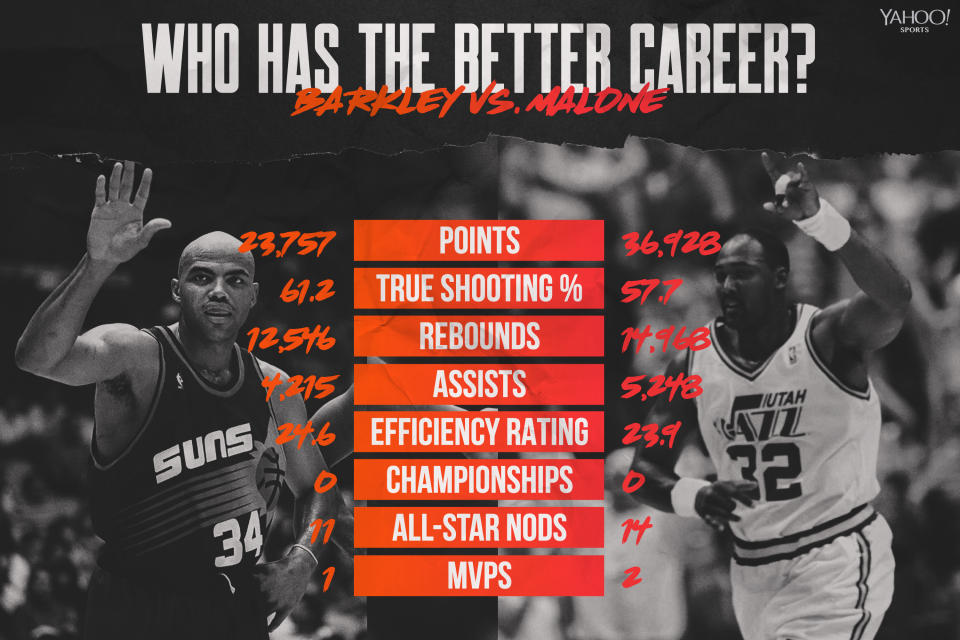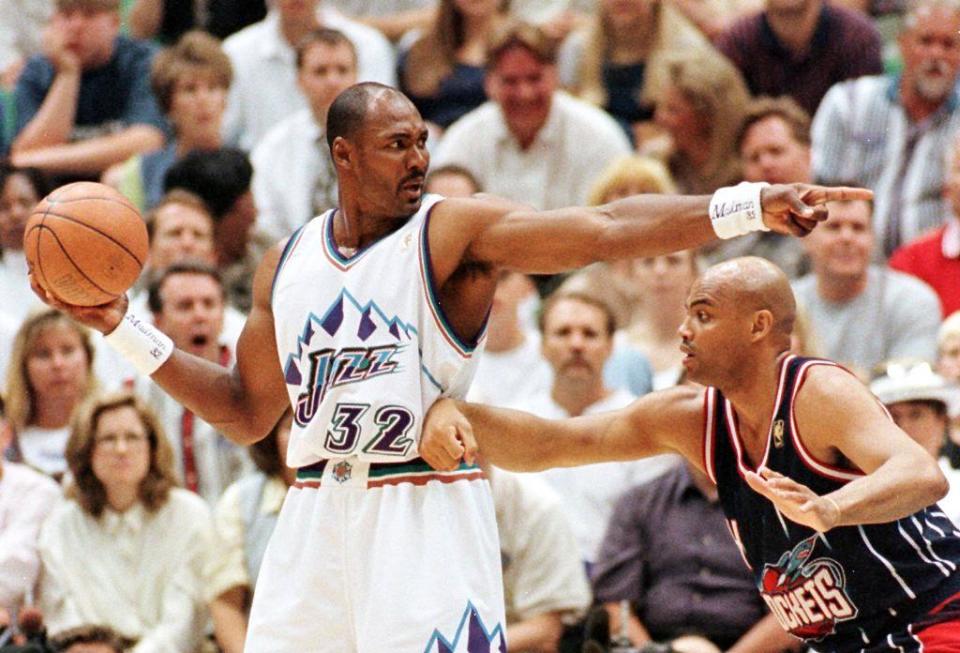Whose NBA career is better? Charles Barkley vs. Karl Malone
Victors are determined decisively on the court, but one great joy of fandom outside the lines has no clear winner. We love to weigh the merits of our favorite players against each other, and yet a taproom full of basketball fans can never unanimously agree on the GOAT. In this series, we attempt to settle scores of NBA undercard debates — or at least give you fodder for your next “Who is better?” argument.
[Previously: Dwyane Wade vs. Dirk Nowitzki • Carmelo Anthony vs. Vince Carter • Kobe Bryant vs. Tim Duncan • Chris Paul vs. Isiah Thomas • Pau Gasol vs. Manu Ginobili • Patrick Ewing vs. David Robinson • Shaquille O’Neal vs. Hakeem Olajuwon • Larry Bird vs. Magic Johnson • Wilt Chamberlain vs. Bill Russell • Jason Kidd vs. Steve Nash • Ray Allen vs. Reggie Miller]
THE MATCHUP: Charles Barkley vs. Karl Malone

Prime numbers
Barkley made his initial star turn from oft-starting rookie role player to double-double machine in Year 2 of his career, and he remained a top-two offensive option through his final All-Star campaign — a 12-year stretch spanning three teams.
From 1985-97, Barkley averaged 23.9 points (54.7 FG%, 27.1 3P%, 73.6 FT%), 12 rebounds, 4.2 assists and 2.6 combined blocks and steals in 37.9 minutes a night. His teams missed the playoffs twice and lost in the first round three times in his prime, reaching three conference finals and the 1993 NBA Finals during that span.
Barkley played with a series of stars. The early stage of his career came on a Philadelphia 76ers team with Hall of Famers Julius Erving, Moses Malone and Maurice Cheeks in their late primes. Both Kevin Johnson and Dan Majerle made All-Star rosters alongside Barkley on the Phoenix Suns. And Barkley’s own late prime coincided with that of Hall of Famers Hakeem Olajuwon and Clyde Drexler.
Malone made a similar star turn in Year 2 and remained a 20-plus points-per-game force until he was 39 years old. He never missed more than a single game during any of those 17 seasons with the Utah Jazz, 14 of which resulted in an All-Star nod.
From 1986-2003, Malone averaged 26 points (51.8 FG%, 27.7 3P%, 75 FT%), 10.3 rebounds, 3.6 assists and 2.2 combined blocks and steals in 37.7 minutes a night. Malone’s Jazz never missed the playoffs in his prime. He lost nine first-round series and reached five conference finals, making back-to-back Finals in 1996 and 1997.
Malone played his entire Jazz career with Hall of Famer John Stockton, forming arguably the most devastating pick-and-roll tandem in NBA history. The Jazz featured just two other All-Stars during their tenures — Adrian Dantley in Malone’s rookie season and two-time Defensive Player of the Year Mark Eaton in 1989.
Barkley owns slight advantages in scoring efficiency, rebounding and playmaking, but Malone was as steady a force as the NBA has ever seen — and extended his prime five years longer than Barkley. Take the Mailman’s consistency every day.
Advantage: Malone
Career high
Following his trade to Phoenix in June 1992, the same summer he led the Dream Team in scoring en route to gold in Barcelona, a resurgent Barkley submitted his masterpiece at age 29. He averaged 25.6 points (on 52/31/77 shooting splits), 12.2 rebounds and a career-high 5.1 assists per game, leading the Suns to a West-best 62 wins and earning MVP honors in a league suffering from Michael Jordan fatigue.
Unfortunately, Michael Jordan was not yet suffering from Michael Jordan fatigue, and the Chicago Bulls legend denied Barkley his best chance at a championship, winning Finals MVP in their six-game set. Barkley averaged 26.6 points (on 48/22/77 splits), 13.6 rebounds, 4.3 assists and 2.6 combined blocks and steals in 24 playoff games, ousting the Lakers, Spurs and Sonics on his way to the Finals.
In the Finals, Barkley averaged 27.3 points (48/25/75 splits), 13 rebounds and 5.5 assists. He dropped a 21-17-4 on 7-for-18 shooting in the series-ending Game 6, a 99-98 loss that was decided by John Paxson’s 3-pointer with 3.9 seconds left.
Malone’s peak met an eerily similar end. During his first MVP campaign, which also fell between Jordan’s fourth and fifth times winning the award, Malone averaged 27.4 points (55 FG%, 75.5 FT%), 9.9 rebounds and 4.5 assists per game for the 64-win Jazz. They too entered the 1997 Western Conference playoffs as the top seed.
And again Jordan destroyed an all-time great’s dreams, capturing Finals MVP honors over Malone in another six-game series. Malone averaged 26 points (43.5 FG%, 72 FT%), 11.4 rebounds, 2.9 assists and 2.2 combined blocks and steals in 20 playoff games, eliminating the Clippers, Lakers and Rockets to reach the Finals.
In the Finals, Malone averaged 23.8 points (44.3 FG%, 60.3 FT%), 10.3 rebounds and 3.5 assists. In the controversial close-out Game 6, which was decided by a 17-foot Steve Kerr jumper that broke an 86-all tie in the final seconds, Malone finished with 21 points (on 7-for-15 shooting), seven rebounds, four steals and two assists.
At their apexes, Barkley was a more formidable foe for Jordan’s Bulls, largely because he posed a more versatile threat offensively. Barkley himself put it best, if you can believe that: “Karl needed John Stockton. That's not a knock on Karl; it's just a fact. I could get mine any time I wanted to. So I'll say it on the record: I was better than Karl. Nothing against Karl. He was great. But I was better. The only thing he did better than me was score, and that came down to John Stockton."
Advantage: Barkley
Clutch gene
Barkley and Malone are two of the greatest players in NBA history never to win a championship, and for that people may assume neither of them performed in the clutch. Truth is, they both enjoyed spectacular performances on big stages, and only Jordan stood in the way of their ultimate victories. This is the reality of being great but not the greatest, as many of LeBron James’ foes are currently learning.
Barkley played in eight advance-or-go-home games in his playoff career (five Game 7s and three first-round Game 5s), finishing with a 4-4 record. He averaged 23.1 points (on 47/22/84 splits), 16.8 rebounds, 2.9 assists and 1.8 combined blocks and steals in those games. His teams lost only one such game as a higher seed.
Barkley played one Game 7 after the second round — against the Seattle SuperSonics in the 1993 Western Conference finals. He amassed 44 points (12-20 FG, 1-1 3P, 19-22 FT) and 24 rebounds opposite Shawn Kemp in a 123-110 victory.
Malone played in 13 advance-or-go-home playoff games (three Game 7s and 10 first-round Game 5s), finishing with a 6-7 record. He averaged 26.2 points (47.2 FG%, 62.9 FT%), 11.1 rebounds, 3.2 assists and 2.2 combined blocks and steals in those games. His teams lost four first-round Game 5s as the higher seed.
Malone also played one Game 7 after the second round — against those same Sonics three years later in the 1996 Western Conference finals. He posted 22 points (8-22 FG, 6-12 FT), seven assists and five rebounds opposite Kemp in a 90-86 loss.
The two Hall of Famers met in the 1997 and 1998 playoffs. Malone out-produced a hobbled Barkley on both occasions, particularly 1998, when Barkley was a shell of himself, playing through a hernia. His availability was questionable, and he was relegated to being a reserve. Yet, Houston held a lead through three games, before Barkley tore his triceps in Game 4 and missed the remainder of a 3-2 series loss.

Those series were hardly representative of their playoff performance. One could just as easily point to the 1993 postseason, when the Sonics beat Malone’s Jazz in the first round before losing to Barkley’s Suns in the conference finals. Barkley’s Suns also took the eventual champion Rockets to seven games one round after Houston eliminated Malone’s Jazz in a five-game first-round series in 1994. Unfortunately, Utah and Phoenix never met when both Barkley and Malone were at their peaks.
Most crucial to any debate about their clutch-ness is probably how they performed against Jordan’s Bulls when it mattered most in the Finals. We mentioned Barkley’s 21 points and 17 rebounds in the Game 6 loss to the Bulls in the 1993 Finals — the biggest game of his career — but those stats hardly reflect how forceful he was in that game. Barkley drew double teams on every possession, and Chicago required 13 fouls from three players to keep him in check. Still, Barkley anchored a Phoenix comeback from the high post, before Jordan and Paxson tore his heart out.
Malone was equally productive in a pair of Game 6 losses to Jordan’s Bulls, both of which came down to the final seconds. He had 21 points and seven rebounds in the 1997 loss, before Steve Kerr tore his heart out. And he dropped 31 points, 11 rebounds and seven assists in the 1998 loss, before Jordan tore his heart out.
The Bulls felt more comfortable defending Malone 1-on-1, if only because they had Dennis Rodman, one of the greatest defenders ever. The Mailman also made big plays down the stretch of both games, but one play swings this conversation away from Malone: His failure to sense Jordan coming when MJ picked his pocket in the post, setting up the legendary series-winning shot. Malone had the ball with a chance to force a Game 7 against a Bulls team running on fumes, and he blew it. The Jazz went to Stockton for their failed final chance with five seconds remaining.
Advantage: Barkley
Hardware
• Barkley: 1993 Most Valuable Player; 11-time All-Star (1991 ASG MVP); 11-time All-NBA selection (5x First Team, 5x Second Team); 1987 rebounding leader; two-time Olympic gold medalist
• Malone: two-time Most Valuable Player (1997, 1999); 14-time All-Star (two-time ASG MVP); 14-time All-NBA selection (11x First Team, 2x Second Team); four-time All-Defensive selection (3x First Team); two-time Olympic gold medalist
This is not even close, which comes as somewhat of a surprise if you had not looked at their résumés in a while. I kind of forgot that Malone won the MVP in the lockout-shortened 1999 season. (Alonzo Mourning finished second and Shaquille O’Neal sixth during Shaq’s prime, which gives you an idea of how wonky that year was — and how much of a void Jordan left behind.) The biggest thing that stands out, though, is the 11 First Team All-NBA selections for Malone to Barkley’s five.
Malone made First Team All-NBA every year from 1989-99. Barkley waited behind guys like Larry Bird, Kevin McHale and Dominique Wilkins for two seasons before making his initial appearance on the First Team in 1988. He shared the frontcourt with Malone in four of the next five years, before being usurped by Scottie Pippen.
In addition to his staying power atop All-NBA rosters, even if he was aided by the presence of a perennial All-NBA point guard (Barkley’s point guards made one All-NBA appearance — Kevin Johnson on the Second Team in 1994), Malone has an additional MVP, three more All-Star Game appearances and the four All-Defensive nods, all of which gives him a clear-cut edge in the hardware department.
Advantage: Malone
For the culture
Both Barkley and Malone are no stranger to public controversy. Barkley spit on a little girl during a game, had a couple barroom brawls as a player and pled guilty to driving under the influence in retirement. Malone was a deadbeat dad — actually worse — and infamously forged a blood feud with Kobe Bryant over “several inappropriate comments” to Bryant’s wife during their lone season as teammates.
Both Barkley and Malone considered gubernatorial runs in their native Alabama and Arkansas, respectively, and both have had some problematic political stances. I’m not sure I want to get into those. I will say their responses to Magic Johnson’s HIV diagnosis created a clear dividing line between the two that falls in Barkley’s favor.
For this argument, though, we should consider the cultural impact both made on the game, and there is no doubt Barkley overshadowed Malone as a larger-than-life character. That has translated into their post-playing careers. Malone is largely content living a life of relative anonymity in rural Louisiana, while Barkley is a fixture in our lives, stealing headlines on a regular basis as the preeminent NBA analyst.
In the end, you might be completely comfortable picking Malone’s career over Barkley’s — the former gave Utah five more prime years and belongs to Salt Lake City in a way Barkley does not to any of his three teams. But if I were picking — and I am — I think I would lean towards Barkley, who was a more complete player at his peak and belongs to basketball in a way that Malone simply never matched.
Advantage: Barkley
THE DAGGER: Barkley is better.
If you have an idea for a matchup you would like to see in this series, let us know.
– – – – – – –
Ben Rohrbach is a staff writer for Yahoo Sports. Have a tip? Email him at rohrbach_ben@yahoo.com or follow him on Twitter! Follow @brohrbach
More from Yahoo Sports:


